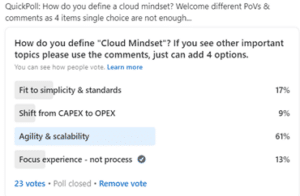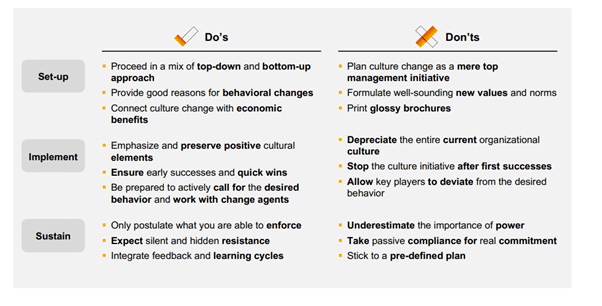Moving to a cloud-based, digital SAP platform is not just about innovative functionality. It actually ignites a complete change in how companies operate their IT landscape and how they think about their daily work. What exactly is this “cloud mindset” and how does it affect learning and change management?
We have come a long way since the early days of cloud computing. When cloud applications entered the world of business IT, executives’ main points of consideration were pricing and costs. For the first time, companies were able to shift their capital expenditures (CAPEX) in IT to operating expenses (OPEX) – thanks to subscription models. The results were more financial flexibility, less risk, and a more reasonable taxing model. For cloud customers, there is no longer a need for owning servers, which means that there is also a lower cost of ownership (TCO) when it comes to IT investments.
In the last couple of years, more and more companies have moved their entire business to the cloud. During that time, a cloud mindset started to take shape. While there is no actual definition of what a cloud mindset is, there are certain perceptions, as a quick poll on LinkedIn shows.

The poll results are by no means a representation of what defines a cloud mindset. Nevertheless, they do reflect the discussion topics that arise among our clients. The diverse backgrounds of the poll participants – developers, consultants, IT managers, and users – also influenced how they voted. Employees today expect IT to be intuitive, personalized, and adaptable. IT operations are no longer here to just keep the lights on, but are expected to help transform the business, automating processes and leveraging technology and integration platforms for new cloud applications. And especially since the pandemic hit, companies have been experiencing the importance of fast adaptability of processes to rapidly changing market situations. Agility is key.
Learning in a Cloud-First World
While managers and employees alike are adopting a cloud mindset, something else is shifting as well in the cloud: our needs on how we learn new skills and how we approach change – for IT experts and users.
Agile working needs to result in agile learning.
The agile approach to working focuses on the users and their more autonomous, iterative, and collaborative way of working. It can be applied to training and learning as well. In an agile cloud-based environment, employees need to drive their personal growth more independently. They decide what, when, and how they learn – in a less formalized and more demand-driven way. Learning becomes explorative, collaborative, and iterative. That doesn’t mean classrooms and guided learning will be replaced, but they will be enhanced by formats such as bar camps, hackathons, mentoring, or learning circles.
Continuous learning is imperative to keep up with the cloud.
When the tools they use every day are constantly updated, employees need a simple, transparent, and quick way to keep up. SAP’s stay current program is an answer to that need. Depending on their role and current experience, SAP experts can learn about the latest functionality of solutions like SAP S/4HANA Cloud, SAP SuccessFactors solutions, or SAP Ariba solutions, and update their knowledge in a granular way. New training content like videos or quizzes are made available for SAP Cloud product releases through SAP Learning Hub. The program offers users a more regular and shorter way to update and keep their SAP Certifications valid.
Learning as a working experience.
Apart from the content itself, the learning experience has become crucial for user adoption. Learning tools need to be user-friendly and customizable. Whether users are learning on their own schedule and device or in the moment of need in the application itself, training must adapt to the user and the respective working context in a cloud world. One way to support this is the SAP Companion service: employees can learn the ins and outs of an application while they are using it, wherever they are. All learning materials are provided through SAP Enable Now and can be changed and updated by knowledge experts within the company.
How the Cloud Impacts Change Management
While adopting a cloud mindset changes companies’ approaches to learning, it also impacts change management. Why?
In general, change management is crucial for any project – and especially when implementing or upgrading to a new digital platform. In the past, however, companies were used to a high degree of IT customization, which made change management a complex task. Time and resources were difficult to estimate and allocate, and some companies refrained from doing it all together. With the advent of the cloud, the paradigm has shifted. IT solutions and processes have become more standardized, thus also influencing change management. It has become easier and faster to plan and put into practice with the right methodology and knowledge. Now, there is no excuse not to do it.
Migrating IT processes to the cloud constitutes a large-scale change. After this initial shift come many incremental changes on a quarterly and even monthly basis, impacting how companies manage their IT operations. As hardware handling is transferred to the cloud vendor, the process and change handling is a new challenge for IT departments – which often changes their operating models as well. For example, they start combining software development and operations of their IT landscape by switching to the DevOps methodology. The cloud and centralization of IT also mean that employees have more central access to data to make decisions based on facts and numbers. The deep transformation insights framework provides a guideline on how change management can be altered to accommodate these changes.
Understanding the impact of the change and the upcoming transformation is the first important step to increasing readiness. That is why SAP considers organizational change management an integral part of project implementation and works to ensure its alignment with methodologies such as SAP Activate – a guided process to help deploy, adopt, and extend new capabilities across an organization.
Thus, it is crucial to educate everyone on the importance and relevance of the cloud. Having clearly outlined benefits and defining expectations for every employee within their specific role will boost confidence and speed up the adoption of the software. It will ultimately also increase the commitment and motivation to change.
Developing a Cloud Mindset Is a Cultural Shift
Mindset plays a critical role in how people cope with life situations. It is a result of our values and attitudes as an individual. And these, in turn, are often shaped by past conditioning and external influences, as we are continually learning and unlearning behaviors. Effective change management therefore does not aim at changing the mindset of individual people. Rather it focuses on influencing the very culture that shapes these mindsets.

With expert knowledge on organizational culture, change, and transformation, for example, companies can lay the groundwork for a successful shift. They need to create environments where growth can thrive and where learning and applying new mental models is just as important as unlearning old ones that no longer serve us.
Thomas Jenewein is a business development manager for SAP Training and Adoption.



